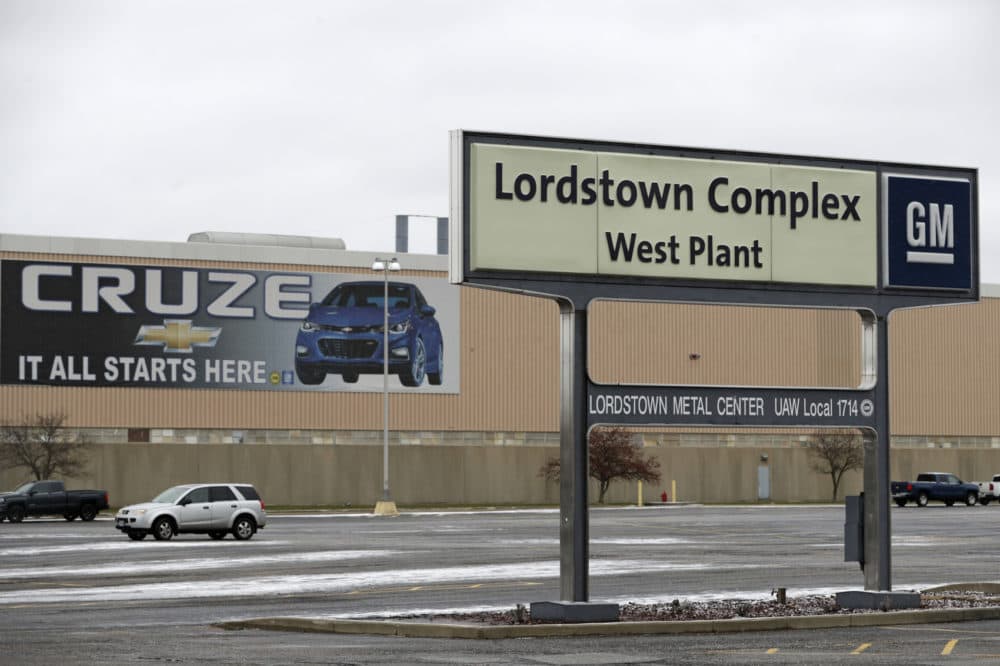Advertisement
1,700 More GM Employees Face Job Loss As Ohio Plant Production Grinds To Halt
Resume
With Meghna Chakrabarti
The last car rolls off the assembly line at the GM plant in Ohio. And with it 1,700 jobs. We hear the message from there and beyond, where the economy isn’t booming.
Guests
Glenn Stevens, special projects director and reporter for WFMJ television. (@21WFMJ)
Heather Long, economics correspondent for the Washington Post. (@byHeatherLong)
Crystal Keaton, business manager for Ohio's Workforce Development Board Area 1. Manager of the Lordstown Transition Center.
From The Reading List
CNN: "Production will end at GM's Lordstown, Ohio plant on Wednesday" — "General Motors is ending production at its Lordstown, Ohio plant Wednesday — two days earlier than previously expected.
"A GM spokesperson said that's when the plant will churn out its last Chevy Cruze sedan. At that point, the factory will be unallocated, which means no vehicles will be assigned to that facility.
"GM planned to idle the 6.2 million-square-foot plant on Friday, but the spokesperson said production was slightly ahead of schedule.
"The automaker announced a major restructuring in November, including the closure of four US plants and another in Canada. It said it would cut 8,000 US salaried and contract jobs, representing a 15% reduction in its workforce."
WFMJ: "Final day GM Lordstown fully staffed" — "The majority of GM Lordstown workers will end their last shifts on Wednesday when the final Chevy Cruze is expected to make it's way off the production line.
"Monday marked the final day the facility was fully staffed with its 1,400 remaining workers.
"'It's not good,' said Bill Alexander of Lake Milton. 'I'm going to hang out and hopefully get into Toledo soon.'
"He's worked 24 years in fabricating at the plant. Alexander said he might have to pack up and move away. Tuesday will be the last time he clocks out."
Curbed: "When towns lose a factory, what comes next?" — "GM’s decision to stop producing cars at the Lordstown, Ohio, factory isn’t the first time that a U.S. city has felt decimated by a factory closing or relocation. It’s been happening for decades.
"Lordstown underlines that, despite an understanding about how these events can damage a community, there still isn’t a robust action plan, especially at the federal level.
"'The United States has an immature array of responses,' says Mark Muro, senior fellow at the Brookings Institution’s Metropolitan Policy Program. 'These kind of closing are viewed as a one-off exception to the rule of prosperity. They’re seen as bugs, and not as a feature.'
"Coming on the heels of Amazon’s HQ2 decision, the GM plan to idle plants can be seen as a story from the other side of the diverging U.S. economy. The economy continues to cluster around big urban areas while rural and heartland regions, which grew up around manufacturing sectors, suffer from diminishing opportunities as these industries shed jobs.
"'We have a great product, but we have it at the wrong time,' Lordstown Mayor Arno Hill told CNN Business.
"But it doesn’t have to be that way. Can the country, as a whole, do a better job of helping former factory towns bounce back?"
Washington Post: "From $22 an hour to $11: GM job cuts in Ohio show a hot economy is still leaving parts of America behind" — "Scott Mezzapeso had to do something last month he never imagined: call his ex-wife and warn her that he might not be able to pay child support on time. Mezzapeso has a tattoo of his daughter on his left arm and rarely misses her high school softball games, but money has become extremely tight. General Motors is shuttering its plant here, and Mezzapeso is one of roughly 5,400 casualties.
"Mezzapeso earned $22 an hour with good benefits at Magna, a GM supplier that made seats for the Chevy Cruze, but he was laid off last summer as the auto giant scaled back Cruze production and suppliers did the same. Now he makes $11 an hour working part time at Bruno Bros. Pizza, the only job he has found after months of sending out his résumé.
"With GM set to shut down production here Wednesday, Lordstown shows how the nation’s booming jobs market is still leaving vast segments of America behind. Last year was the best for manufacturing jobs in more than two decades, but the Youngstown, Ohio, region where Lordstown is located has continued to lose manufacturing jobs in recent years. About a quarter of the country’s metro areas have faced the same fate, many in the Rust Belt, according to data provided by the Federal Reserve Bank of New York."
Brookings Institution: "Countering the Geography Of Intent: Strategies for the Left-behind places" — "The 2016 election revealed a dramatic gap between two Americas—one based in large, diverse, thriving metropolitan regions; the other found in more homogeneous small towns and rural areas struggling under the weight of economic stagnation and social decline.
"This gap between two American geographies came as a shock to many observers.
"While it is true that many American leaders had grown disconnected from a significant portion of the country, something else had happened, too: the nation’s economic trends had changed.
"For much of the 20th century, market forces had reduced job, wage, investment, and business formation disparities between more- and less-developed regions. By closing the divides between regions, the economy ensured a welcome convergence among the nation’s communities.
"However, in the 1980s, that long-standing trend began to break down as the spread of digital technology increasingly rewarded the most talent-laden clusters of skills and firms.
"As the economy changed, convergence gave way to divergence, as a fortunate upper tier of big, dense metropolitan areas (the top 2 percent of U.S. communities based on measures of growth and wages) began to consistently grow faster than the median and least-prosperous cities."
Allison Pohle produced this hour for broadcast.
This program aired on March 7, 2019.